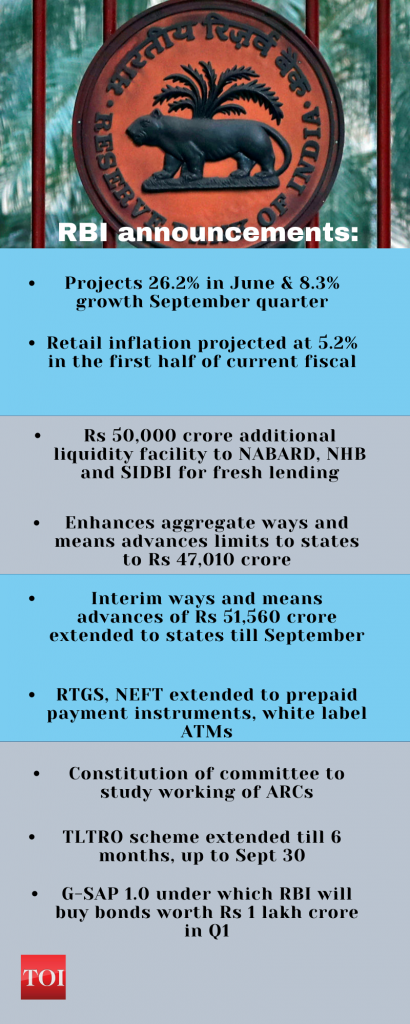Context:
The Monetary Policy Committee (MPC) of the Reserve Bank of India (RBI) voted unanimously to leave the policy repo rate unchanged at 4%.
Relevance:
GS-III: Indian Economy (Economic Growth and Development in India, Monetary Policy)
Dimensions of the Article:
- Instruments of Monetary Policy
- RBI’s MPC decision
- Highlights of what was said by the RBI Governor
Instruments of Monetary Policy
There are several direct and indirect instruments that are used for implementing monetary policy.
- Repo Rate: The (fixed) interest rate at which the Reserve Bank provides overnight liquidity to banks against the collateral of government and other approved securities under the liquidity adjustment facility (LAF).
- Reverse Repo Rate: The (fixed) interest rate at which the Reserve Bank absorbs liquidity, on an overnight basis, from banks against the collateral of eligible government securities under the LAF.
- Liquidity Adjustment Facility (LAF): The LAF consists of overnight as well as term repo auctions. Progressively, the Reserve Bank has increased the proportion of liquidity injected under fine-tuning variable rate repo auctions of range of tenors. The aim of term repo is to help develop the inter-bank term money market, which in turn can set market based benchmarks for pricing of loans and deposits, and hence improve transmission of monetary policy. The Reserve Bank also conducts variable interest rate reverse repo auctions, as necessitated under the market conditions.
- Marginal Standing Facility (MSF): A facility under which scheduled commercial banks can borrow additional amount of overnight money from the Reserve Bank by dipping into their Statutory Liquidity Ratio (SLR) portfolio up to a limit at a penal rate of interest. This provides a safety valve against unanticipated liquidity shocks to the banking system.
- Corridor: The MSF rate and reverse repo rate determine the corridor for the daily movement in the weighted average call money rate.
- Bank Rate: It is the rate at which the Reserve Bank is ready to buy or rediscount bills of exchange or other commercial papers. The Bank Rate is published under Section 49 of the Reserve Bank of India Act, 1934. This rate has been aligned to the MSF rate and, therefore, changes automatically as and when the MSF rate changes alongside policy repo rate changes.
- Cash Reserve Ratio (CRR): The average daily balance that a bank is required to maintain with the Reserve Bank as a share of such per cent of its Net demand and time liabilities (NDTL) that the Reserve Bank may notify from time to time in the Gazette of India.
- Statutory Liquidity Ratio (SLR): The share of NDTL that a bank is required to maintain in safe and liquid assets, such as, unencumbered government securities, cash and gold. Changes in SLR often influence the availability of resources in the banking system for lending to the private sector.
- Open Market Operations (OMOs): These include both, outright purchase and sale of government securities, for injection and absorption of durable liquidity, respectively.
- Market Stabilisation Scheme (MSS): This instrument for monetary management was introduced in 2004. Surplus liquidity of a more enduring nature arising from large capital inflows is absorbed through sale of short-dated government securities and treasury bills. The cash so mobilised is held in a separate government account with the Reserve Bank.
RBI’s MPC decision
- The marginal standing facility (MSF) rate and the bank rate remain unchanged at 4.25% and the reverse repo rate stands unchanged at 3.35%.
- Taking various factors into consideration, the projection of real GDP growth for 2021-22 has been retained at 10.5% consisting of 26.2% in Q1; 8.3% in Q2; 5.4% in Q3; and 6.2% in Q4.
- The RBI Governor said that while headline inflation at 5.0% in February 2021 remained within the tolerance band, some underlying constituents were testing the upper tolerance level.
- Taking into consideration various factors, RBI has revised the projection for CPI inflation to 5.0% in Q4: 2020-21; 5.2 % in Q1:2021-22; 5.2% in Q2; 4.4% in Q3; and 5.1% in Q4, with risks broadly balanced.

Highlights of what was said by the RBI Governor
- The RBI Governor said that the focus must now be on containing the spread of the virus as well as on economic revival — consolidating the gains achieved so far and sustaining the impulses of growth in the new financial year (2021-22).
- The RBI Governor said that the juxtaposition of high frequency lead and coincident indicators reveals that economic activity is normalising in spite of the surge in infections.
- Drawing on its experience in the previous year, the RBI, for the year 2021-22, has decided to put in place a secondary market G-sec acquisition programme (G-SAP 1.0) under which the RBI will commit upfront to a specific amount of open market purchases of government securities with a view to enabling a stable and orderly evolution of the yield curve amidst comfortable liquidity conditions.
Click Here to read more about the Monetary Policy Committee (MPC) and Inflation Targeting
-Source: The Hindu



